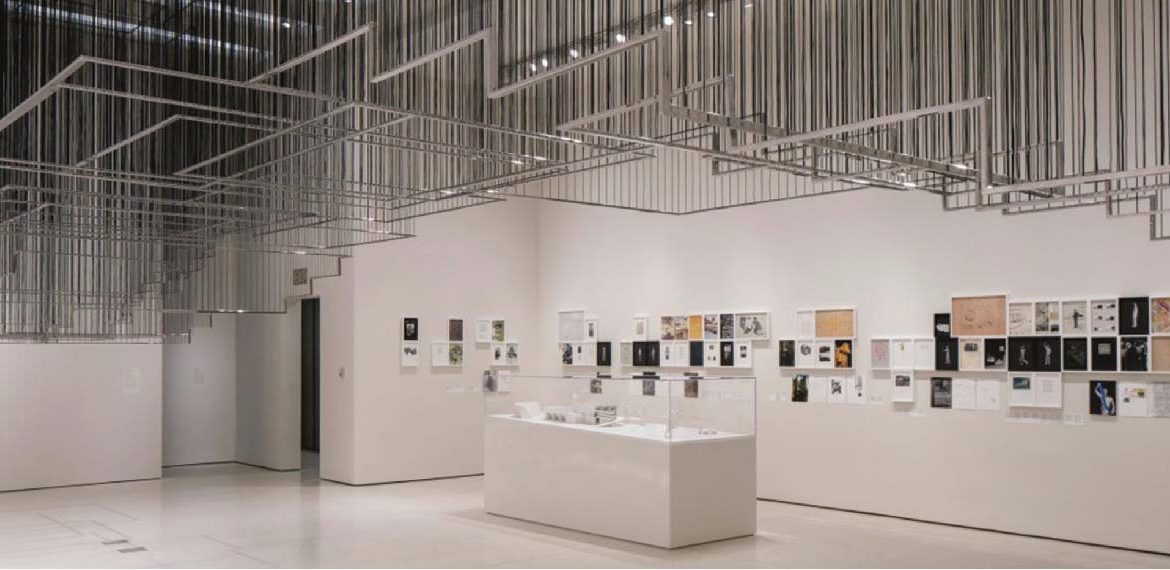Whether it’s stereotyping someone or being a victim of stereotype, we’ve all been on both ends. It is society’s way of categorising us into groups so that we are examined, rationalised and tailored to meet certain perceived ideals. Yet, each one of us is unique and diverse at the same time. For some of us, like myself this notion is something I often feel compelled to challenge. A few weeks ago the Guggenheim Museum in New York launched an exhibition featuring the works of Middle Eastern and North African artists, challenging preconceived ideas. The exhibition titled ‘A Storm is Blowing from Paradise’ based on German philosopher, Walter Benjamin’s excerpt from ‘Theses on the Philosophy of History’. The theme was chosen to highlight the connection between politics and perception.
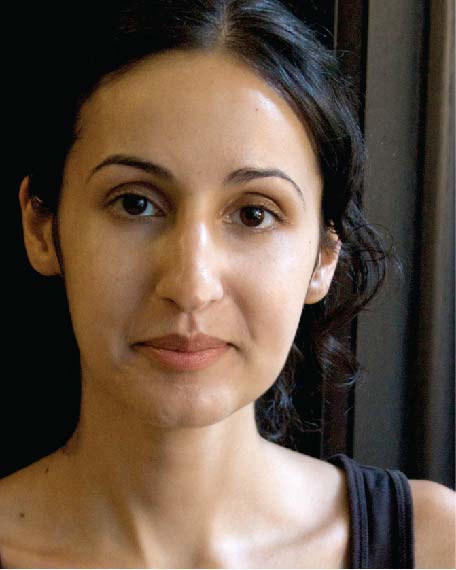
Artist Mariam Ghani’s two channel installation, ‘A brief history of collapses,’ shows the parallels of two buildings in two simultaneous videos; the Museum Fridericianum in Kassel, Germany and the Darul Aman Palace in Kabul that draws the viewers’ attention towards architectural similarities in the two cultures. Also on display. is the ‘Flying Carpets,’ a mobile made of stainless steel and rubber tubes by Nadia Kaabi-Linke. It is a reference made to the magic carpet narrative as well as the blankets that street vendors use to pack and transport their wares. All the artworks from the region fulfils the curator’s desire to merge the global symbolic significance of pattern and geometry and its aesthetic tradition. In an interview to BBC World, Ghani highlighted the cultural awareness in light of the political rhetoric that is served by some of today’s presidential hopefuls in the US. She also focused on the importance of bringing Middle Eastern art to New York in order to highlight global bonds that art and artists can bring irrespective of who they are.
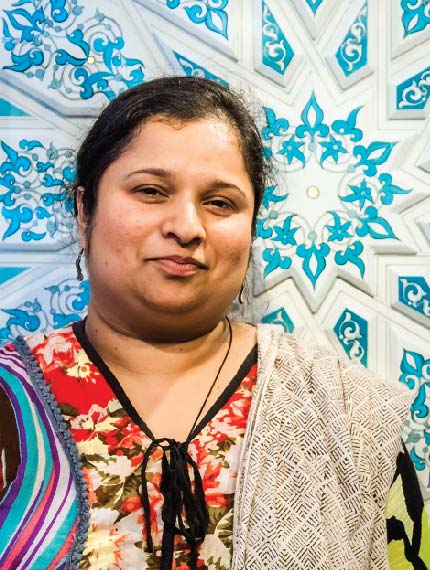
British Bangladeshi artist Tasleema Alam, now residing in Dhaka, has been invited by Southbank Arts Centre UK to conduct a workshop on South Asian heritage for the Alchemy festival in May and explains that sacred art communicates a language of the ‘Ever True.’ Mathematical forms embedded in nature and exploring these patterns helps to relate our existence to our immediate environment. “It is an art that transcends all definitions and boundaries focusing on what unifies rather than what divides us all” she adds. She further highlights, “be it Leonardo’s ‘Mona Lisa,’ the Taj Mahal, the Great Pyramid, the cubic Ka’ba or the Mandalas of eastern faiths, there are universal geometric codes that transcend race, religion and culture. It is a contemplative art that liberates us from the definitions we use to categorise ourselves,”. The compelling quality of sacred art is to reflect, be inspired and seek a coherent connection to our unity in an ever-divisive global sphere. “Islamic art, though not geographically bound, is a revival of ancient wisdoms from various cultures; an artistic tradition par excellence by Muslim scholars/ artisans which has universal appeal and is currently seeing a global renaissance,” she adds. There is resurgence toward such patterns today. Fashion brands such as H&M, Banana Republic and Dolce & Gabbana are using what was traditionally seen as Islamic art patterns to filter into mainstream fashion markets and thereby breaking the chains of stereotyping through art and fashion.
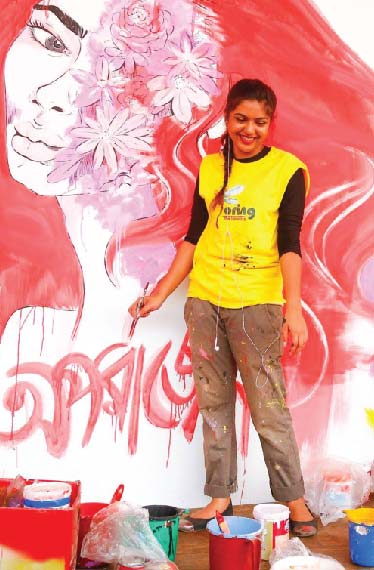
I also sat with Maleena Dhrity Gomez, who recently showcased her work at ‘The InvisiBellas.’ This was a street art project initiated by the Dhaka Hub of Global Shapers, aiming to illustrate real-life situations faced by local women in today’s society. Hosted at Bengal Art Lounge, it was an artistic movement aimed at breaking the existing mindset of the masses so that women can be praised for their work and not what society perceives them to be. Maleena’s artwork titled ‘Aparajaya’ – undefeated, portrays the beauty within acid victims and not the physical scars that they are left with. For Maleena, the art was a personal journey. “While travelling in a three-wheeler someone threw a liquid at me. My first reaction was, is it acid?” she explains with tears in her eyes. Luckily, for Maleena the ordeal was only psychological as it was dirty water instead. However, the experience made her aware of the trauma such patients go through and have to live with. That helped her reconsider what beauty is? Is it one’s complexion, one’s physique, one’s hair or facial features, or is it something deeper? “For acid victims, it’s a constant struggle to show the beauty that lies within them and to break free from outwardly impressions,” she explains. further elaborated, “ This was why I thought of portraying women with beautiful flowers blooming from the scars. It’s my way of showing the beauty within them.”
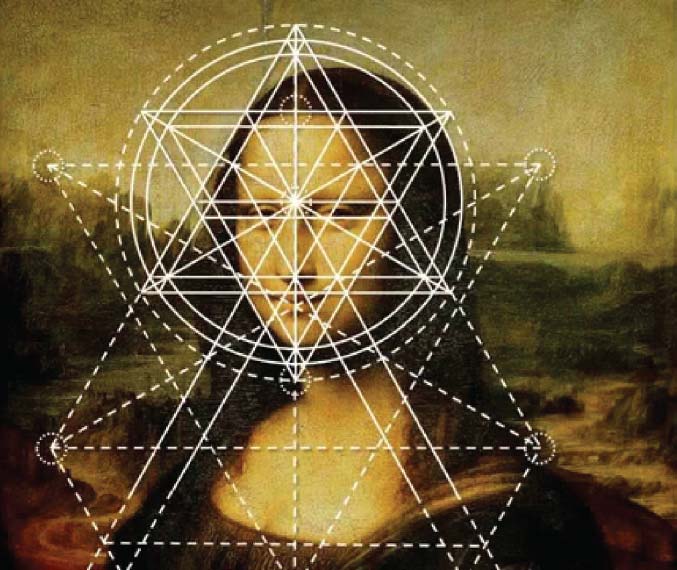
The media is constantly bombarding us with certain ideals, as a result we are often confused as to what our identity is or what our ideals should be. Am I fair or dark? Am I fat or thin? Is my hijab a means of subjugation or liberation? Is my dress Western or Eastern? And in this confused world, artists, both traditionalist and modernist, are breaking these barriers to introduce new viewpoints. Be it global fashion brands using traditional art to create new fashion, young Bangladeshi artists who are changing social perceptions or iconic art institute that fight off fascism, art and artists are breaking the stereotype and helping us redefine who we really are.

